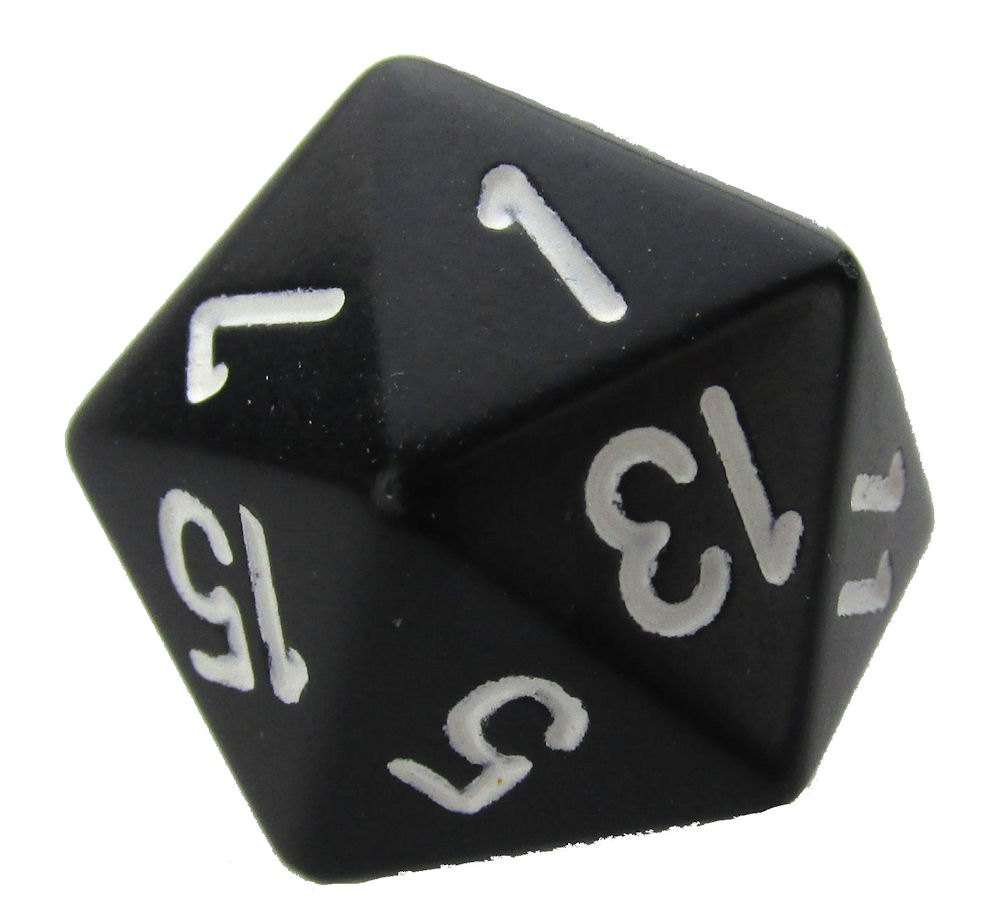 Welcome back to Wally D.M. Yesterday’s post featured the Critical Hit Chart that I am currently using in my Pathfinder campaign. Today I want to take a look at my critical miss chart aka critical fumbles table. I first started using the critical miss table in the 1990s, calling natural 1 rolls “Misfortunes”. During my D&D Red Box days rolling a natural 1 usually meant that a player was disarmed in combat and had to retrieve their weapon. However, after introducing the lavish rewards in my critical hit chart for rolling a 20, I felt that it was only right to do the same for the opposite end of the spectrum.
Welcome back to Wally D.M. Yesterday’s post featured the Critical Hit Chart that I am currently using in my Pathfinder campaign. Today I want to take a look at my critical miss chart aka critical fumbles table. I first started using the critical miss table in the 1990s, calling natural 1 rolls “Misfortunes”. During my D&D Red Box days rolling a natural 1 usually meant that a player was disarmed in combat and had to retrieve their weapon. However, after introducing the lavish rewards in my critical hit chart for rolling a 20, I felt that it was only right to do the same for the opposite end of the spectrum.
Since getting back into fantasy role playing games this year, I have read some posts where game masters and players alike do not care for the Critical Miss Chart. It could be argued that rolling a natural 1 and having something “bad” happen to the character, punishes classes that receive multiple attacks. Point made. For those opposed to the idea I would recommend that only a single instance of a “misfortune” to characters with multiple attacks. It can also be argued that combat classes such as Fighters are skilled in the arts of combat and should never suffer the ill-fate of a natural 1 on the d20. Sure, but it can also be argued that characters are still human (or elf, or dwarf, or…) and prone to mistakes. Maybe the GM or DM will cap a negative result on a natural 1 to just one occurrence in a session for skilled combatants. When bad things from this chart happen, maybe they can be explained by environment/terrain, the character’s psychological state, an unexplained supernatural interference or just blame it on the gods of their world being displeased with their actions or lack of efforts in utilizing their combat skills.
Regardless, I have found no disappointment in my campaigns as Dungeon Master. The results on my Critical Miss Chart below have allowed for some great moments and have challenged the adventurer’s to overcome their misfortunes.
| d20 | Critical Miss Chart – Misfortunes |
|---|---|
| 1 | Ultimate Failure: A random ability score is permanently lowered by one point. The gods are displeased. |
| 2 | Blister: Character gets a blister on his/her hands and suffers a -4 penalty on “to hit” rolls until healed. |
| 3 | Concussion: Character is hit in the head by falling down, on the next attack received in combat, or by nearby environmental hazards (part of a dungeon ceiling collapsing maybe?). Must SAVE vs FORTITUDE or be unconscious for an additional 1d4 rounds. If the SAVE is made, the character will still be stunned and confused resulting in missing their next round of actions. |
| 4 | Disadvantage: Character now makes all d20 rolls at DISADVANTAGE for a length of time set by the DM. (Every time he/she rolls a d20, they roll two instead and take the lesser roll – see 5th Edition D&D rules for more info) |
| 5 | Disarmed: Character is disarmed and weapon lands behind opponent. Characters not using weapons will miss wildly, invoking an attack of opportunity with opponent getting a +2 to hit. |
| 6 | Disarmed: Character is disarmed and weapon lands to the side of him/her. Characters not using weapons will miss wildly, invoking an attack of opportunity with opponent getting a +2 to hit. |
| 7 | Disarmed: Character is disarmed and weapon lands behind him/her. Characters not using weapons will miss wildly, invoking an attack of opportunity with opponent getting a +2 to hit. |
| 8 | Equipment Damage:: Part of the characters normal equipment is damaged or lost in battle. Backpack or Sack may rip, waterskin or canteen becomes punctured, torches split, sheath or belt breaks etc. The result could also result in lost treasure, food, water or other items spilling into the battlefield becoming lost, damaged or a hazard to others (DM Choice). |
| 9 | Armor Damage: Normal Shield is destroyed and beyond Repair. Magic Shields get -1 permanently. If no Shield then armor will be damaged and the character will lose 1 point of Armor Class for each successful hit until destroyed (Again, if magical, -1 permanently). If not wearing armor then normal clothes or robes are ripped. |
| 10 | Exposed: Terrible Swing and a miss, exposing the character to an attack of opportunity. For characters using ranged attacks maybe the monsters focus on him/her, either all moving to attack, throwing a rock, or have their own archer in the group. |
| 11 | Scarred: Permanently lose 1 H.P. |
| 12 | Illness: Character becomes light headed and then ill for 24 hours or until cured. This flu-like virus can cause nausea, vomiting, movement at half speed and a -X negative penalty to hit rolls and damage rolls. Onset after the roll may be a few turns. |
| 13 | Bad Luck: All attack and damage rolls made with this weapon suffer a -1d4+1 penalty for a period of time determined by the DM |
| 14 | Stunned: When the character misses in melee or ranged, the weapon hits a hard surface or backfires causing vibrations and a jolt through the funny bone stunning the character for a full round. The character can take no actions while stunned and skips his/her next turn. |
| 15 | Strained Muscle: Character pulls or strains a muscle. -2 on hit and damage rolls for 1 day or until healed. |
| 16 | Trip: Character trips and falls giving opponents an attack of opportunity. Will need to use their next turn’s move action to get up. |
| 17 | Weapon Damage: Normal weapons will break and become worthless, magical weapons will lose a magical property or -1 to a bonus. |
| 18 | Inspire Enemies: All opponents are inspired by your inept attack and now receive +2 to all of their attack/damage/save rolls until end of combat. |
| 19 | Freak Hit: The wild combat swing or ranged attack accidently hits yourself or an ally for 1/4 of normal damage (rounded up) |
| 20 | Freak Hit: The most awkward combat maneuver finds a way to still find its target for a freak hit! Roll for damage! |
So what do you think? Look fun? Please comment below!
On to the Next!
—wallyd
Oh, and if you would like to see the YouTube Video I created where I discuss this chart, well… here you go!
Old Critical Hit Chart from the 1990s


